Scapa Flow attack
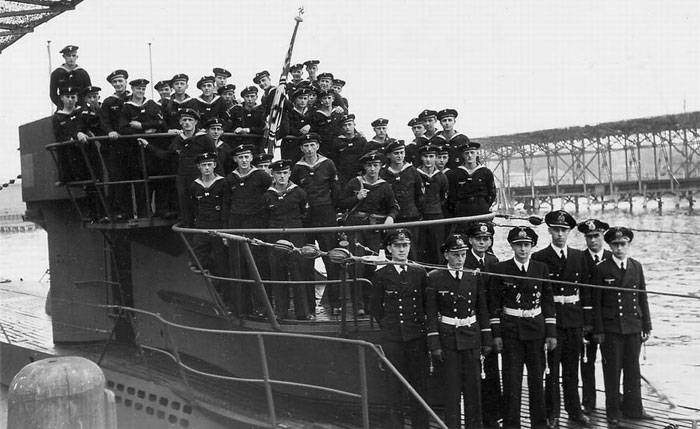
В stories The Second World War, and in particular the war at sea, there are events and names of people who were simultaneously surrounded by both the aura of high military professionalism and mystery.
One of these striking events is the penetration of the German submarine U-47 under the command of Lieutenant-Commander Gunther Prien into the heart of the Royal Navy fleet Great Britain, its holy of holies is the Scapa Flow site, located in the north of Scotland, in the Orkney Islands. Easily bypassing booms, minefields and blockhouses, U-47 launched a torpedo attack on the ships stationed at that time, and just as easily returned to its base.
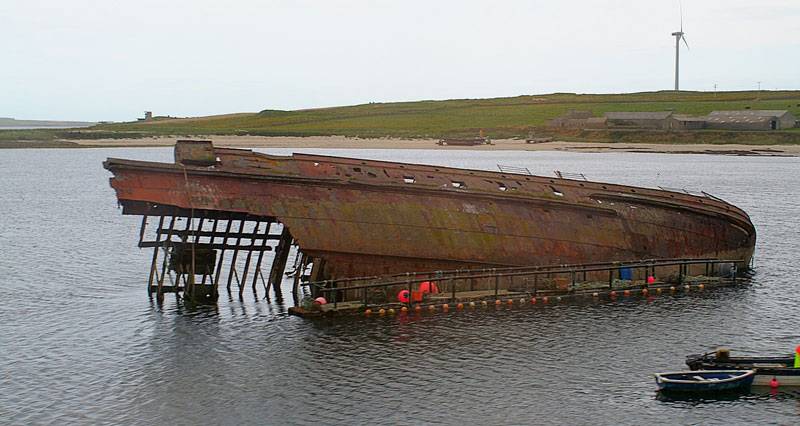
Blockhouses in Scapa Flow
The second element of this event was its close intertwining with a mysterious person who, myths and legends, is firmly tied to the attack in the harbor of Scapa Flow - the officer of the German military intelligence, which brought the German submarine to the British ships. This mysterious stranger has a lot of names - these are Alfred Ortel, and Alfred Wehring, and Albert Ertel ...
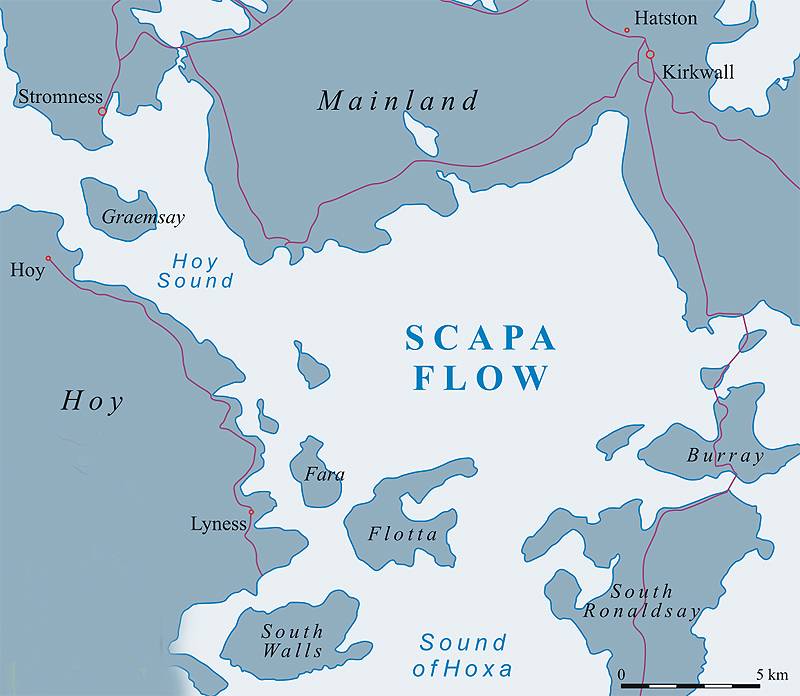
Scapa Flow Map
Let's start in order.
The idea of the penetration of German submarines into the Scapa Flow harbor was in the air even in the First World War, and the British Royal Navy located there was a very, very tempting target for the Kaiser's submarines.
The British Admiralty chose this convenient in all respects natural harbor on the Orkney Islands for its anchorage, and earlier all attempts of German submariners to penetrate it to attack British ships ended in failure.
When World War II broke out, the German sailors returned to their old idea of attacking the British fleet at its main base, Scapa Flow. The commander of the German submarine forces, Karl Doenitz, nevertheless believed that such an operation had a chance of success.
To collect preliminary information, the U-14 submarine was sent for reconnaissance to the Orkney Islands under the command of Chief Lieutenant Victor Erne, which obtained valuable data on sea currents, lighthouses and the defense system of the main British base, and Luftwaffe reconnaissance aircraft provided the German submarine headquarters with good aerial photographs of all obstacles in each of the harbor passages.
Having carefully studied them, Doenitz came to the conclusion that the defense system of the main station of the British Royal Navy was seriously flawed. If the main entrances to the harbor were protected by anti-submarine barriers and guarded by patrol ships, then the small straits, of which there were many, the British Admiralty did not pay due attention, hoping that the enemy submarine would not be able to pass through them.
This was a mistake.
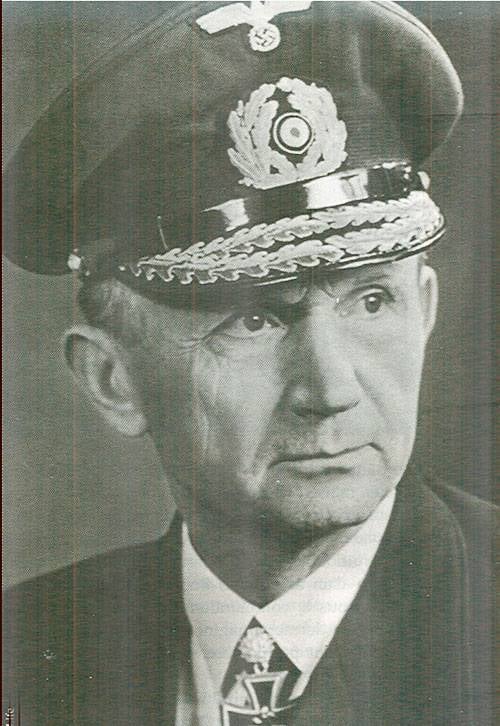
Karl Doenitz
As Admiral Karl Doenitz writes in his memoirs "Ten Years and Twenty Days", published after the war, the operation to infiltrate the main parking lot of the Royal Navy was prepared in deep secrecy and with German thoroughness at the headquarters of the German submarine forces. a limited circle of naval specialists.
In addition to mines, booms and hulks, the main difficulties in the covert penetration of a submarine into Scapa Flow were unusual currents with a speed of about 10 miles per hour. And at the same time, the maximum speed of the submarine is no more than 7 miles per hour, and it is simply not able to withstand such a powerful current.
After carefully analyzing all these difficulties, Doenitz's operation against Scapa Flow seemed like a pure gamble, but, on reflection, he nevertheless decided that it was worth trying, and his choice fell on Lieutenant Commander Gunther Prien, commander of the U-47 submarine, who, in his opinion, he possessed all the personal and professional qualities necessary to carry out such a task.
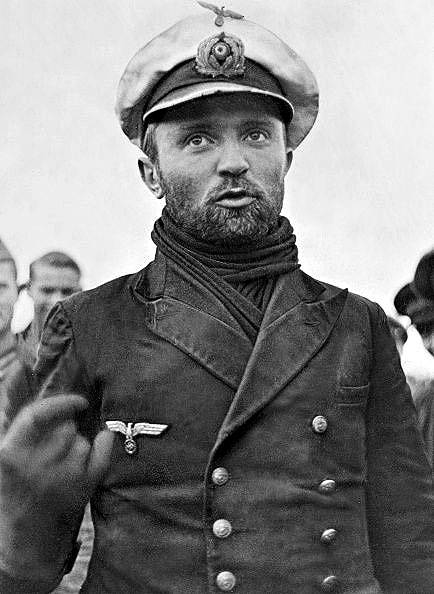
Gunther Prin
The admiral gave the candidate for the operation all the materials he had collected and gave him the opportunity to decide in 48 hours whether he would undertake such a task or not. After reflection, Lieutenant Commander Prien accepted the offer and the next day reported to Doenitz about his readiness to complete this task.
The attack was scheduled for the night of October 13-14, a choice facilitated by the calm weather and the new moon. And the purpose of the operation was a torpedo attack on the ships, which, according to the German naval headquarters, were in the harbor, so it was decided that the submarine would only have torpedoes on board and not a single mine.
On the morning of October 8, 1939, in secrecy, U-47 left Keele and moved carefully towards the Orkney Islands. And on the morning of October 13, she approached the entrance to the Scapa Flow bay, where Lieutenant Commander Prien informed the crew of his main task. Going on such a responsible mission, Gunther Prien deliberately avoided any contact with the courts, even if they were tempting targets for attack.
Arriving at the entrance to the bay, Gunther Prien decided to wait until dark, and with the onset of dusk, overcoming the oncoming current and avoiding collisions with the fences, the boat crept unnoticed into Scapa Flow.
Upon entering the bay, Prien experienced the greatest disappointment - despite the information gathered by air reconnaissance, the anchorage was empty! All the main forces of the British fleet were at sea. It was only half an hour later that he managed to spot two ships: the battleship Royal Oak and the old aircraft carrier Pegasus, and from a distance of four thousand yards he fired four torpedoes. But one device did not work, and of the three torpedoes fired, only one exploded near the battleship.
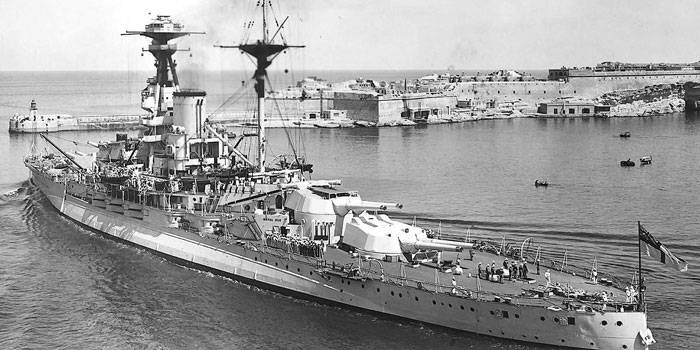
Battleship "Royal Oak" ("Royal Oak")
After reloading the torpedo tubes, Prien launched a second attack, firing four more torpedoes at the Royal Oak, two of which exploded, detonating the artillery cellars. A deafening explosion sounded in the air, tearing a battleship with a displacement of 31 tons in two. Debris flew into the air, the attacked battleship capsized and sank in 200 minutes, killing the commander of the Second Battleship Division Rear Admiral Henry Blangrove and 23 sailors (of 832 people) - members of his crew.
Despite the commotion that arose after the torpedo attack in Scapa Flow, Prinu managed to slip out of the harbor just as unnoticed, going back the same way, and heading for Wilhelmshaven, where the submarine, accompanied by two destroyers, arrived three days later.
In Wilhelmshaven, she was already greeted by a jubilant crowd, a military band and Grand Admiral Raeder, who climbed aboard the boat and personally shook hands with all the sailors, presenting each of them with an Iron Cross of the II class.
After that, Prien and his crew flew to Berlin on Hitler's private planes, where they were all greeted as triumphants - all the streets on the way from the airfield to the Kaiserhof were crowded with a jubilant crowd shouting “we want Prien”, and he personally reported to the Führer about the course of the operation. Hitler received them in his Reich Chancellery and awarded Pryn with the Knight's Cross, and in the evening Goebbels received the sailors at the Winterganter Theater.
Captain Prien earned high praise even from the enemy for his bold actions.
So, Winston Churchill gave this event the following description:
And here is what Admiralty historian Stefan Roskilde says in his book War at Sea about the attack:
A mole in Scapa Flow?
After such a successful operation, Captain Prien's actions could not fail to attract the attention of the world press, which gave rise to many myths about his penetration into the parking lot in Scapa Flow.
One of these myths, still circulating today, is the parable of a German spy who infiltrated the Orkney Islands long before the outbreak of the war, who probably pointed the German submarine at the anchorage of the battleship Royal Oak.
This story was first published in the spring of 1942 in the American magazine The Saturday Evening Post by the famous journalist Kurt Riess. According to Riess, Scapa Flow's spy was Captain Alfred Wehring, a former officer in the German Kaiser's fleet.
After the end of the First World War, under the terms of the armistice, all German ships were concentrated in the Scapa Flow raid, where they were sunk by their crews. And one of the German officers, then still young, there was Alfred Wering, who, after the sinking of the ships, was on the verge of poverty, penniless. He was a military sailor whose only hobby was watches ...
After the end of the war, the German newspaper Deg Kurier published an article entitled "The Man Who Sank the Royal Oak" (Der Mann, der die Royal Oak versenkte), where it was argued that the hero of this operation was not Lieutenant Commander Prien at all, but the military - naval officer, hero of the Battle of Jutland, Alfred Wehring (aka Alfred Ortel and aka Albert Ertel), who, disguised as a watchmaker, settled on Orkney and closely watched all the movements of the British fleet.
According to this legend, Alfred Wehring (hereinafter we will call him by this name) first studied watchmaking in Switzerland, and in 1927 he arrived in Great Britain under a different name as a citizen of neutral Switzerland. Under this new name, he managed to open a watch workshop and a jewelry store in Kirkwall, the administrative center of the Orkney Islands.
As an excellent watchmaker, a modest and quiet man, Wehring managed to win the respect of the locals, who did not even suspect that in reality they were repairing their watches at the hero of the Battle of Jutland and a German spy. And, of course, a considerable part of his clientele were naval sailors, from whom he extracted useful information in the course of ordinary everyday conversations.
Creating the appearance of a loving and respectable son, Vehring sent a monthly letter to his "homeland" in Switzerland to his old father, who lived in Zurich. In reality, the letters of this "loving and respectable son" were very carefully studied at the headquarters of the German naval intelligence.
In these letters "to his aged father," Alfred Wehring described in detail the state of the British fleet and the entire coastal defense of the harbor. At the same time, the "Swiss" was collecting data on the fleet base in Scapa Flow, and just before the start of the war, he learned about the existing "hole" in its defense - the presence of a passage in its eastern part. Vehring managed to send a message using a radio transmitter, which was received by the naval attaché in The Hague, and as a result, a submarine under the command of Lieutenant Commander Gunther Prien was sent to the Orkney Islands.
And here is what the former intelligence chief Walter Schellenberg writes about this in his memoirs:
And now - in response to the pre-agreed light signals, an inflatable boat, launched from U-47, approached the shore, into which a "modest and quiet watchmaker" sat down with a roll of maps under his arm.
The German spy masterfully guided the boat through all the obstacles he knew and brought it to Scapa Flow harbor, where the entire British fleet was located. As mentioned above, almost the entire British fleet left the bay, and two ships were parked - the battleship Royal Oak and the much outdated aircraft carrier Pegasus.
The target of the torpedo attack was the battleship "Royal Oak" and the aircraft carrier "Pegasus", which was the last in the line of ships, which was hated by Vehring since the time of the Battle of Jutland. The submarine made two torpedo attacks, after which she left Scapa Flow, taking the German scout to Germany. And the next morning, Wehring's watch shop did not open, his house was found empty, and his abandoned car was found on the road ...
Arriving home in Germany, Alfred Vehring met with Admiral Canaris and, having reported to him about the completion of the assignment, disappeared. And where exactly he disappeared, nobody knows ...
Aftermath
1. Immediately after these events, the British Admiralty strictly ordered all its Scapa Flow naval personnel to avoid the press in every possible way and not to answer any questions.
2. One of the results of this attack was the disbelief of the British Admiralty in the safety of its main naval base.
3. Prine's torpedo attack became a real advertisement for German submariners, and the success of the operation made them heroes in the eyes of the whole of Germany.
4. The German submarine forces received the green light for their further development, which their commander Doenitz previously could only dream of.
5. The commandant of the islands, Admiral Wilfred French, was removed from his post.
Help
1. U-47 - German submarine, laid down on February 25, 1937 at the shipyard in Kiel. Launched on October 29, 1938. From the very moment the submarine was put into operation, its commander was Lieutenant Commander Gunther Prien. Crew - 45 people.
The crew of the boat destroyed 30 enemy ships with a total displacement of 162 gross register tons and the British battleship "Royal Oak" (displacement of 769 tons), and also damaged 29 more ships with a displacement of 150 tons.
In 1941, the boat did not return to base. The circumstances of her death are still unknown.
2. U-14 - small submarine, laid down on June 6, 1935 at the shipyard in Kiel. Launched on December 28, 1935. The commander is Chief Lieutenant Victor Ern. Crew of 25 people.
3. Gunther Prin - U-47 commander, the most productive submariner, holder of the Knight's Cross with Oak Leaves. He disappeared without a trace with the crew after the attack on the convoy.
4. Scapa Flow - harbor in the Orkney Islands, the main anchorage of the British fleet. In 1956, the Scapa Flow car park was closed.
Scuba divers are not allowed to access the remains of the battleship Royal Oak - they are among the underwater mass graves protected by British law.
Information